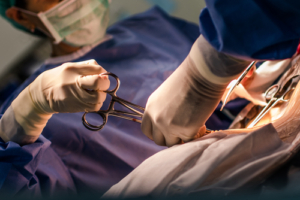 The United States has one of the highest rates of cesarean sections globally. In some cases, a C-section can be life-saving. In other cases, babies can suffer a catastrophic and irreversible birth injury. For some doctors, the jump to do a C-section has a lot to do with avoiding medical malpractice charges. If a vaginal birth goes wrong, the question will be: “Why didn’t you do an emergency C-section?” But birth by cesarean is not necessarily better or safer than a vaginal birth. There are possible complications in both situations.
The United States has one of the highest rates of cesarean sections globally. In some cases, a C-section can be life-saving. In other cases, babies can suffer a catastrophic and irreversible birth injury. For some doctors, the jump to do a C-section has a lot to do with avoiding medical malpractice charges. If a vaginal birth goes wrong, the question will be: “Why didn’t you do an emergency C-section?” But birth by cesarean is not necessarily better or safer than a vaginal birth. There are possible complications in both situations.
There is no way to avoid a C-section with 100% certainty, but there are measures that can be taken to try to prevent a C-section and the likelihood of medical malpractice.
Research your doctor.
Some expectant mothers like their OB/GYN to be part of a group of doctors, so they can rotate through each obstetrician throughout their pregnancy and get to know them all in preparation for delivery day. Nevertheless, working with multiple doctors means you have more doctors to research.
Ask questions about a doctor’s C-section rate, especially in their treatment of first-time mothers, and whether they are inclined toward vaginal births or vaginal birth after a C-section (VBAC). While there is no guarantee that you will know the doctor on call when you’re in the delivery room, heading into that space feeling good about the obstetrician you’re working with can help ease your mind and give you hope for the journey ahead.
Ultimately, you must feel comfortable with your doctor and trust that they know and plan to honor your intentions for your birth. If you want your doctor to help you deliver vaginally at all costs, choose a doctor who is confident with vaginal births.
Research hospitals.
Many obstetricians have privileges at more than one hospital. If you live in an area where you get to choose where you deliver, do your research before making a final selection and compare the C-section rates for the labor and delivery wards at all relevant hospitals.
Gathering this information may be a challenge as not all states or hospitals are required to publish these details, but start with a Google search. You can also call the hospitals to ask for the information or seek out advocacy organizations that may be able to provide relevant statistics.
Research C-sections.
It helps to understand the reasons for and against C-sections. Some doctors opt for a C-section automatically in the case of multiples, breech birth, or a lengthy labor. Some doctors feel more comfortable with this type of delivery in general, but research shows that C-sections are overused in the U.S. and, for a low-risk mother and baby, can be more dangerous.
You’re not expected to make the big decisions when you’re in the throes of labor and delivery. However, if you are educated about what could happen and when C-sections are warranted, should an emergency arise you will find some relief in your knowledge of your situation.
Get Support After a Traumatic Delivery
C-sections save lives, especially in times of prolonged labor, placental abnormalities, cord prolapse, fetal or maternal distress, and certain diseases, but C-sections done unnecessarily or poorly can cause birth injuries that lead to lifelong conditions like cerebral palsy.
If you or your baby have been a victim of medical malpractice because of an unnecessary or badly performed C-section, schedule a consultation with the birth injury lawyers at Thurswell Law to discuss your situation. Get the compensation you deserve for your medical bills and suffering. We do not charge any fees unless you collect. Call (248) 354-2222 today.







